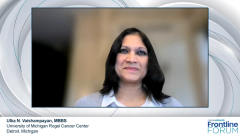
Overview of First-Line Treatment Options for Advanced RCC
Opening their discussion on the advanced renal cell carcinoma treatment landscape, experts Ulka N. Vaishampayan, MBBS, and Moshe Ornstein, MD, identify cornerstone first-line regimens.
Episodes in this series

Transcript:
Ulka N. Vaishampayan, MBBS: Hi, everyone. Thank you for joining the CancerNetwork® Frontline Forum program titled “Recent Advances in the Treatment of Clear Cell and Non–Clear Cell Kidney Cancer.” My name is Ulka Vaishampayan, and I’m from the University of Michigan [in Detroit]. I’m a medical oncologist who focuses on treatment and clinical research of kidney cancer. I’d like to introduce my friend and colleague, Moshe Ornstein, [MD], from the Cleveland Clinic, who will be participating in the discussion today and sharing thoughts about kidney cancer. Please introduce yourself, Moshe.
Moshe Ornstein, MD: Hi, Ulka. Thanks so much. It’s great to be here. My name is Moshe Ornstein, and I’m a genitourinary oncologist at the Cleveland Clinic in Ohio, where my clinical research focus is on the treatment and [the development and design of] clinical trials [for] kidney cancer.
Ulka N. Vaishampayan, MBBS: Thank you for joining, Moshe. This program is an extension of a meeting that Dr Ornstein and I had with a group of other expert faculty members around the International Kidney Cancer [Symposium] just a few days ago. We were discussing the current landscape of kidney cancer treatment. In the next 30 minutes, [we] will discuss recent data updates and share our insights on how they can be applied to clinical practice for patients with advanced RCC [renal cell cancer]. Let’s begin.
Moshe Ornstein, MD: I’ll start by asking you a question, Ulka. How do you currently select frontline systemic therapy for patients with advanced clear cell RCC? There’s many options out there, [such as] IO [immuno-oncology] and TKIs [tyrosine kinase inhibitors]. What do you take into consideration when you have a patient in front of you in the clinic?
Ulka N. Vaishampayan, MBBS: There are several factors to consider. Patient wishes and shared decision-making holds a key part of our discussion when we are trying to decide [on] frontline therapy. From an evidence standpoint, the biggest consideration is the IMDC [International Metastatic RCC Database Consortium] risk factors. These are risk factors that help us put patients into favorable, intermediate, and poor risk [categories, which] helps us determine their long-term prognosis and overall survival. For patients with favorable risk, you have more time, [as] they’re relatively less symptomatic. That would be factored in when you’re considering a treatment. They may do better with combinations of VEGF [vascular endothelial growth factor], TKI, and IO vs patients who have very aggressive, fast-growing disease. It’s sort of a mix between considering a VEGF TKI that’s likely to give you a response and adding an IO or an IO/IO combination, such as nivolumab and ipilimumab. The other factors are the patient’s symptomatic condition. If they have symptoms such as recurrent pleural effusions, where you need a rapid response…VEGF TKIs relatively tend to give you quicker responses than immunotherapy alone. Sometimes if the patient is admitted to the hospital,it’s somewhat easier to start an oral agent.
Other things to consider are autoimmune diseases and other comorbid conditions, such as cardiac disease [or] maybe a relative contraindication to using VEGF TKI, [then] you would lean more toward using an immune-based therapy. There are factors that are not covered in the IMDC factors. [For instance], how do you treat some patients with liver and bone metastases? Some of these are extremely comorbid conditions in advanced kidney cancer.
Moshe Ornstein, MD: I completely agree with what you said. You must take the IMDC criteria at least into consideration, and ipilimumab and nivolumab are approved only in intermediate- and poor-risk disease.
I take a similar approach. I find that we have this shared decision with the patient. [However], for a patient who is symptomatic, where I feel like they really need a response…I usually give either [cabozantinib and nivolumab] or lenvatinib with pembrolizumab in that setting. [With] a patient who’s less symptomatic, I feel [they] can go on [ipilimumab and nivolumab] because there’s less of a chance [for] rapid progression. The IMDC does have some limitations, because we know from clinical practice that patients with liver, bone, and brain metastases—even though they don’t fall into the IMDC criteria—they’re poor actors. Those cancers [generally] don’t do well.
Ulka N. Vaishampayan, MBBS: Exactly.
Moshe Ornstein, MD: I tend to use that in combination with the patient’s symptoms. I don’t view any 1 criterion in isolation. A patient with liver and bone metastases—especially with emerging evidence of the role for IO/TKI with [cabozantinib and nivolumab] and [lenvatinib and pembrolizumab]—in those settings, I lean more toward IO/TKI. One exception is sarcomatoid histology. Historically, this was notoriously challenging to treat, in terms of histologic subtype, but we’ve found that patients do extremely well with IO-based therapy, especially with IO plus IO. If I’m summarizing my approach, I use patient symptoms first and foremost. If they need a response, it’s IO/TKI. I lean more toward IO/TKI if they have bone and liver metastases. Otherwise, IO/IO with [ipilimumab and nivolumab] is a very reasonable and appropriate consideration, especially given the long-term data we have. For patients with sarcomatoid features, I certainly favor giving ipilimumab and nivolumab.
Transcript edited for clarity.
Newsletter
Stay up to date on recent advances in the multidisciplinary approach to cancer.
























































































